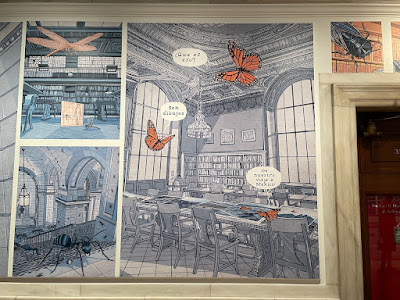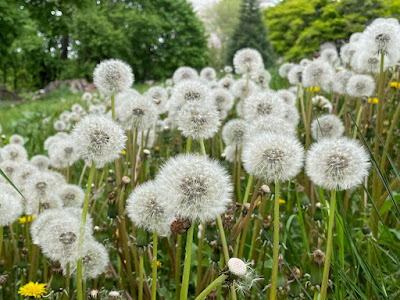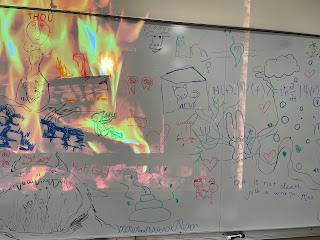18 May 2006
First Presbyterian Church of New York
(DEADLY EARNEST) This is a tough time to be graduating. As oilmen and evangelists look on, our common life has been hollowed out and our democracy lies wounded. Unjust war dishonestly entered has shattered international trust and strengthened forces of reaction around the world. The languages of justice and decency have been made parodies of themselves. Who would want to make a home in this false world, let alone be mad enough to think they could change it? We need a new heaven and a new earth—or a revolution!
(PAUSE, SMILE) I’ve always wanted to say something like that in a place like this—but didn’t think I’d ever have a chance! Certainly when I showed up at Lang four years ago—like many of you graduating today—the last thing I’d ever have imagined was that we’d end up here—a church! (LOOK AROUND CHURCH IN WONDER.) Graduating here must be a bit like getting to Carnegie Hall when you’ve been auditioning for “Avenue Q”!
Shall the Fundamentalists Win?
Actually, this place, The First Presbyterian Church of New York, is more appropriate for a Lang commencement than you might expect. It’s known among historians of American religion for a famous sermon, delivered from that pulpit over there (POINT) by one Harry Emerson Fosdick. The sermon was called “Shall the Fundamentalists Win?” A live question even today, but it was delivered in May of 1922, just a few years after the founding of fundamentalism. The New School at that point was still in Chelsea and going through the first of a series of identity crises which, as you know, hasn’t ended yet. Fosdick was so popular that the balconies filled to overflowing when he preached. Legend has it that during one of his sermons, the church nearly split in two—literally. A crack almost the length of the church opened up in the marble of the center aisle. You can still see traces of it today [POINT].
Maybe that happened during “Shall the Fundamentalists Win?” Although Fosdick’s point was precisely to prevent schism, to insist on the value of new as well as old ideas. He said “We must be able to think our modern life clear through in [religious] terms, and to do that we also must be able to think our [religious] life clear through in modern terms.”
These were fighting words, because “modern terms” meant historical criticism and—Darwinian evolution. Although an influential liberal theologian, Fosdick argued for the inclusion of all views. His objection to the Fundamentalists was their “intolerance,” their efforts to silence progressive views and to make the church an enclave, armed to the gills against the world around it. Hiding can’t solve the problem of reconciling “the new knowledge and the old faith,” he argued; it only makes the problem worse.
While this congregation supported him, Fosdick was denounced at the General Assembly of the Presbyterian Church and in 1925 he left for the newly-established Riverside Church uptown, which he led for over forty years. That same year, 1925, his chief Presbyterian persecutor met his maker after a celebrated trial of a substitute biology teacher in Dayton, Tennessee. Fosdick’s persecutor’s name was William Jennings Bryan and the biology teacher John Scopes.
A sermon heard round the world, the first challenge to Fundamentalism—launched from right here! This block between 11th and 12th Streets and Fifth and Sixth Avenues in Manhattan, was progressive even before the New School got here. I’m sure most of you have walked past this place a hundred times without giving it a thought. (I know I have, and I teach a class called "Religious geography of New York.")
So one piece of advice I give you as you graduate—I am, I think, supposed to be giving you advice—is: wherever you go, get to know the neighborhood. You’ll find friends and conversation partners in the most unexpected places!
(QUIETER, ALMOST SADLY) But all levity and preachiness aside, what I said in opening is true: This is a tough time to be graduating. The fundamentalists seem to be winning. I can imagine some of you feel unprepared for this two-faced world, but let me tell you I’m hopeful. You give me hope. The problems are grave, but you have what it takes to face them.
The Crisis in Democracy
I’ll focus on just one problem, the crisis in democracy. It’s exacerbated by others I could mention: widening inequality, the consequences of globalization, the trivialization of education, the worldwide resurgence of religion. Don’t be surprised that I mention religion as a problem. As Marx could tell you, people turn to otherworldly hopes and the communities which support them when this world frustrates the expression of their humanity. All people seek a way to make a home, to make a difference. Religion can offer people a chance to do this when nothing else does. But when it has to answer these needs, it has little space for tolerance.
But back to democracy: I think we’ve forgotten what it’s about. We think it’s about freedom, the freedom to do what you want—and the devil take the rest. The problem with democracy understood this way is that it predictably, indeed inevitably creates and reinforces social exclusion and inequality. America-watchers abroad were horrified but not surprised at the abandonment of the poor and of minorities exposed by Hurricane Katrina and its continuing aftermath. This is a society which has removed the social safety net, and passes its debts down to the seventh generation. It’s no wonder that people feel left out or left behind. Those who can, flee into enclaves—religious, political, academic, aesthetic, virtual, residential, narcotic. Marketing enclaves as lifestyle choices, consumer capitalism lets us think we’re being democratic by freely choosing our own personal way of forgetting our fellows.
But while democracy is about the right and the beauty and the importance of self-determination, of choosing your values and your friends, it’s also about something else. It’s about sharing decision-making with people you didn’t choose, who just happen to live here too. (That’s why democracy naturally points beyond the limits of the nation-state to cosmopolitanism and universal human rights.) And on this front we’re in deep trouble. It still angers me to think about the separatist—indeed nearly genocidal— fantasies that accompanied the maps in red and blue of votes in the 2004 presidential election. We in the “blue” states hugging the borders felt ourselves being pushed into the sea. With a kind of bitter joy some of us dreamed of seceding before we were driven out, leaving behind a moral wasteland. And yet even when you broke things down county by county, the land proved everywhere shades of purple.
What grieves me is not that we’re divided between red and blue—we’re not—but that we’re receptive to so dangerous a misdescription of our national life. The last two presidential elections showed no clear division, but a lot of people disenchanted in the middle. We were told that the election of 2004 was being discussed across kitchen tables throughout the land. Remember that image? What happened to it? Have the kitchen-table seminars stopped?
John Dewey, one of our founders, would point out that we have to understand sharing decision-making with others as a responsibility, and indeed as an opportunity, if our democracy is to live. Somehow America needs to be redemocratized from the ground up.
But I’m hopeful. Because of you. Because of what you’ve learned here at Lang.
The Seminar
Some of you may be wondering just what it is that you’ve learned here. You may be having a hard time describing it to your friends and family—and even to yourselves. Let me tell you: you’re going to have to explain this to a lot of people for a long time, so you’d better start figuring out what your story is! Beyond your concentration, what has your time at Lang, a liberal arts seminar college, given you?
It’s not that easy to explain. More and more people think “liberal arts” is irrelevant by design, as opposed to being, say, relevant even when designs fail. But liberal arts is still easier to explain than a seminar college.
Four years makes (at a rough estimate) fifteen hundred hours of seminars—that’s a lot of talk! Is it anything more? In fifteen hundred hours you could have listened to nearly 130 of the lecture courses offered on CD and cassette by The Teaching Company. If you’d listened to them while jogging, you’d be fit, too! But what would you have learned that you couldn’t get by skimming a book?
There is a basic difference between a lecture-centered and a seminar-centered curriculum. What lectures do well—convey established knowledge and narratives, and make you good data managers—seminars tend to do less well and vice versa. In most places, lectures are the default model of what knowledge is, even in seminars. Here it’s the other way around.
Seminars are sometimes fractious and often unsettling. They have twists and turns, and sometimes get off track. But we’re here because we think the things seminars do well are more valuable, and equip you better to make a home in the world, and to make a difference in it. Indeed, in seminars and workshops and internships, you’ve been making a home and a difference already.
Whatever else you learned in your fifteen hundred hours of seminars, you picked up some valuable habits I’m old-fashioned enough to want to call virtues, from healthy impatience with authority claims to an awareness that, since the seminar is a collective project, you owe it to others no less than to yourself to do the work of preparing for it. These virtues are democratic virtues. They help you think and act and engage others in a democratic way.
Most important, they give you democratic expectations. It’s better to be able to make some craft or body of knowledge your own than just to have it dictated to you by a lecturer. But you know that it’s even better than that to be there as others make it their own. They ask questions you would never have thought of—you or your professors. They open up new possibilities, problems, connections. The object of study becomes truly three-dimensional as different people fix it in their sights. You and your classmates become three-dimensional too.
Sure, not every question is illuminating, but the one that is makes the whole thing worthwhile. Often the question or observation that cracks things open comes from an unexpected place in the room, from someone who hasn’t said much before, or who’s changed her mind since her last contribution. People sometimes say the point of the seminar is that everyone gets a chance to express their point of view. But that’s not the half of it. The value of a seminar lies in its being a place where people change their minds, and aren’t afraid to admit it. Do you have any idea how rare and precious this is?
So here’s another piece of graduation advice: expect to keep changing your mind, and seek out friends and settings which welcome such changes and even provoke them.
One final feature of the seminar, generally unremarked because it’s so basic: You don’t get to pick who else is there. Sure, people are more cliquish in their class choices than they might be, and Lang is far from being as diverse as it should be. But the fact remains: nobody controls who’s in the class. You don’t get to choose your interlocutors, and they don’t get to choose you. Show up at the start of a semester, and there’s a room full of other people whose interests and schedules have somehow brought them to the same place.
Perhaps the single most valuable thing you learn in a seminar college is to take for granted that this is a good thing. You learn from your teachers, your research, your creative expression, your friends—but in a seminar, in workshopping a poem, in doing dance improv or working on a theater production, you learn to learn from strangers, and you expect to learn from them. Contrary, perhaps, to appearances, the seminar is the anti-enclave.
I taught a course last Fall on the religious right. Some people were surprised that it filled quickly—I wasn’t. What did surprise me was that there was an Evangelical student! I was worried her presence would produce a sterile “us vs. them” dynamic, and this did indeed happen at first. But not for long. “Us vs. them” got old fast, and unconvincing even faster as the seminar took its course.
When at the end of the semester we discussed how the course might be improved, student after student testified to the importance of having her in the room. The next time around, they suggested, I should try to get two or three students from The King’s College—Lang’s Evangelical Christian double in Midtown—to enroll. Not just occasionally visit: enroll. The thought filled me with terror—and then with hope. Terror, because The King’s College is all about penetrating places like ours. But hope because I realized we would be ready for them, not to shout them down but to learn with them. Faculty learn from their students all the time, especially in a seminar college, but on that day I learned something about my own enclavish tendencies, and how Lang gives me the confidence to overcome them. To me, that was a prophetic moment.
Conclusion
Harry Emerson Fosdick moved uptown soon after he delivered the sermon “Shall the Fundamentalists Win?” But just a few years later a new kid arrived on the block, The New School, an experiment in socially engaged research and lifelong education. In little time, this new kid had established a fascinating circle of friends from abroad and from the arts. Eventually someone started something called “The Seminar College,” and twenty one years ago Eugene Lang College was born. It’s about the same age as most of you. Through the growth spurts and identity-crises, you’ve grown up and are ready to go out make your mark.
So here’s my advice to you as you graduate: Wherever you go, and I hope you go far, get to know the neighborhood. You’ll find friends and interlocutors in the most unexpected places. (GESTURE TO THE CHURCH) Sometimes even religion is on the side of the angels!
Wherever you go, and I hope you go many places, don’t be afraid to change your mind, and seek out friends and settings which welcome and even provoke such changes. An interesting life has twists and turns; it’s more like a good seminar than a lecture.
And finally, wherever you go, take the virtues and expectations of the seminar with you. You’ll redemocratize the world.
This is a tough time to be graduating, but if you take the seminar with you, the fundamentalists won’t win. Congratulations, class of 2006!

 The old school year must indeed be over. Not only did I submit the final grades for my last two students but I started thinking in earnest about next semester. I guess I haven't shared here my new course for the fall, in part because it was just a promissory note. The topic is vast and wonderful, like the tree of life in Gustav Klimt's Stoclet Frieze, better known in chopped up form but really horizont-al, space-defining and all-embracing.
The old school year must indeed be over. Not only did I submit the final grades for my last two students but I started thinking in earnest about next semester. I guess I haven't shared here my new course for the fall, in part because it was just a promissory note. The topic is vast and wonderful, like the tree of life in Gustav Klimt's Stoclet Frieze, better known in chopped up form but really horizont-al, space-defining and all-embracing.















.jpeg)









.jpg)



.jpeg)


















